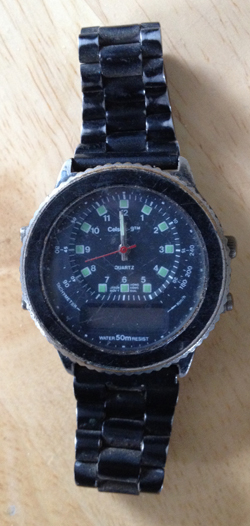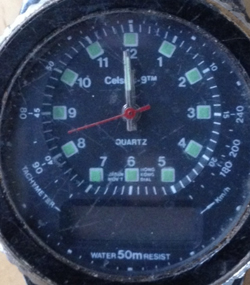 |
|
|||
 |
 |
|||
Copyright © Harry Rinker, LLC 2016 Questions
and Answers
QUESTION: My father had a Raffoler wristwatch, made ANSWER: To be blunt, junk the watch. It is a knock-off and not worth repairing. “Made in Hong Kong” is one clue. I am surprised the watch worked as long as it did for your great uncle. In the May 7, 1988 issue of “The New York Times,” Michael Hines authored an article entitled “Mail-Order House of a Hundred Names.” It begins: “If you’ve ever been intrigued by an advertisement for a startlingly cheap watch, toy, perfume, or pearl necklace, you may have been looking at the handiwork of Raffoler Ltd. “Not that you’d know. Raffoler, also known as Direct Stephen Brown and Jerry S. Williams owned Raffoler, located in Westbury, Long Island. At its peak, it employed more than 500 employees and sent out over 300 million advertising pieces. Raffoler specialized in low-cost knock-offs of popular brand names. Celsius is a luxury brand watch that sold in the thousands of dollars, even back in 1988. They never used the brand name trademark that appears on the face of your watch. For more information, see: http://www.nytimes.com/1988/05/07/style/consumer-s-world-mail-order-house-of-a-hundred-names.html. Raffoler in its many guises is gone. The F.T.C. and other consumer watchdog agencies finally succeeded in causing it to cease operations. According to www.businesslookup.com, the company has been inactive since December 31, 1995. The reasons jewelers or watchmakers refused to repair your watch are (1) replacement parts for cheap imported knock-offs are not available and (2) a recognition that the cost to repair the watch would be more than its value once it was repaired. The only value the watch has is its memory value to your father and you. QUESTION: I like to attend estate and garage sales on weekends. At a sale on February 14, 2016, I purchased a “Little Cut-Up” jigsaw puzzle cut by H E. Hamlen of 128 Davenport Street in Chicopee, Massachusetts. The 356-piece puzzle, although there are more pieces in the box than this by my count, is titled “Stopping at the Brook.” Having been born and raised at 16 Davenport Street, I have more than a passing interest in this puzzle. What information can you provide about Mr. Hamlen, his jigsaw puzzles, the date he made them, and the retail value of the puzzle I acquired? – JB, South Windsor, CT, Email Question ANSWER: I had an example of a “Little Cut-Up” puzzle in my former jigsaw puzzle collection. Internet research revealed sale results for several “Little Cut-Up” puzzles, including the one from my collection. Information about H. E. Hamlen was minimal, surprising given the strong interest in puzzle cutters’ biographies by members of the Association of Game and Puzzle Collectors. It is time to correct this. H. E. Hamlen’s full name is Harold Eugene Hamlen (1893-1955). Using www.findagrave.com, I found his burial location and that of his wife Mildred Shaw Ward Hamlen (1895-1922) – Arms Cemetery, Shelburne, Franklin County, Massachusetts. The website http://www.markwing.com/genealogy/get person.php?personID=I5366&tree=tree1 provided additional genealogical information. I am a fan of reference librarians. An email inquiry for information about Harold E. Hamlen to the Chicopee Public Library (449 Front Street, Chicopee, MA 01013) resulted in an email from Brigitte Bisailon, Reference Librarian, that contained four references from newspaper stories about Hamlen, his family, and his obituary that appeared in the October 11, 1955 issue of the “Springfield Union.” The following biographical sketch incorporates information from the above sources. Harold Eugene Hamlen was born on February 5, 1893 in Cummington, Hampshire, Massachusetts. His parents were Theron Orcutt Hamlen (April 9, 1842 – May 19, 1909) and Hattie Laura Lovell (January 14, 1858 – November 12, 1946). Harold attended Cummington schools and graduated from Sanderson Academy in Ashfield. Harold married Mildred Shaw Ward (March 11, 1895 – November 5, 1992) in Cummington, Hampshire, Massachusetts. The marriage occurred on March 2, 1918, the date Harold was furloughed from the army. Harold and Mildred had two children Betsy Laura Hamlen (April 29-1923 – August 11, 2008) and Ward Lovell Hamlen (December 15, 1926 – July 20, 1990). Harold Hamlen served in World War I. His tombstone reads “2D LT / QMC-RES / WORLD WAR I.” Following their marriage, Harold and Mildred moved to Chicopee Falls, Massachusetts. Harold began his professional career at the Fisk Tire Company. Following that, he served over 20 years as the assistant treasurer of the Springfield Facing Company. While in Chicopee, Harold and Mildred were members of the Federated church. The “Spring Daily Republican” (Wednesday, Mach 8, 1943) ran a story on page 8 with the dateline “Chicopee, March 2” and titled “HAMLENS OBSERVE 25TH ANNIVERSARY: Davenport Street Couple Holds Open House, Receiving Gifts, Congratulations From Many Friends.” The opening paragraph notes: “Hundreds of Hampden county families will remember Mr. Hamlen as the man, who, through his home wood-working hobby, popularized jig-saw puzzles, some of simple patterns and others of intricate design, contributed much to the happiness in the home when jig-saw puzzles took the public’s fancy.” Harold and Mildred moved back to Cummington in 1945. Harold and Mildred became active in the Village Congregational Church. Harold was a charter member of Post 304 of the American Legion. At the time of his death, Hamlen was living at the Soldiers Home in Holyoke. Harold E. Hamlen cut jigsaw puzzles during the 1932-1934 jigsaw puzzle craze. Because he used primarily generic scenes for his images and did not include figural pieces in his cuttings, Hamlen’s Little Cut-Up puzzles do not command a high price on the secondary market. Valuing your “Stopping at the Brook” jigsaw puzzle without knowing if it is complete is difficult. A jigsaw puzzle collector might pay $5.00 to $10.00 and take the risk, especially if the piece count is at or above that which appears on the box lid. Complete, your jigsaw puzzle is worth between $45.00 and $55.00. QUESTION: I have a hand carved wooden bottle stopper featuring a man and woman. When a lever in the back is pressed, the faces of the man and woman rotate to create the appearance that the couple is kissing. I purchased this at an estate sale and am having trouble finding information about it. I would appreciate any input you may have. – LO, Email Question. ANSWER: You “kissing figures” bottle stopper is made by Anri, an Italian company. Anri’s origins date back to the late 19th century when Alois Riffeser traveled to European toy shows to sell hand carved figurines and toys made by farmers in the Gröden Valley located in South Tyrol, at the time part of the Austro-Hungarian Empire and annexed by Italy in 1919. Joseph Riffeser founded ANRI in 1912. While a prisoner during World War I, he formulated the concept for his company. Thomas Riffeser is the fifth generation family member to head the company. Anri made a number of action bottle stoppers. The “yakker” opens and closes its mouth. The “hat-tipper” works by pulling a string with a ball attached to the end. The “kissers” work via a lever. Most Anri bottle stoppers found in America date from the post-1945 period. The company stopped producing bottle stoppers in the 1960s. Anri “kissers” are common. Examples are listed for sale on the internet for prices ranging from $15.00 to a high of $40.00.Harry L. Rinker welcomes questions from readers about
collectibles, those mass-produced items from the twentieth and twenty-first centuries.
Selected letters will be answered in this column.
Harry cannot provide personal answers.
Photos and other material submitted cannot be
returned.
Send your questions to: Rinker on Collectibles, 5955 Mill
Point Court SE, Kentwood, MI 49512.
You also can e-mail your questions to
harrylrinker@aol.com.
Only e-mails containing a full name and mailing address
will be considered.
You can listen
and participate in
WHATCHA GOT?, Harry’s
antiques and collectibles radio call-in show, on Sunday mornings between 8:00 AM
and 10:00 AM Eastern Time.
If you
cannot find it on a station in your area,
WHATCHA GOT?
streams live on the Internet at www.gcnlive.com.
SELL, KEEP OR TOSS?: HOW TO DOWNSIZE A HOME,
SETTLE AN ESTATE, AND APPRAISE PERSONAL PROPERTY
(House of Collectibles, an imprint of Random House Information Group, $17.99),
Harry’s latest book, is available at your favorite bookstore and via
www.harryrinker.com.
|
||||
 in Hong Kong, that his uncle gave him before he died. My great uncle was a woodsman in Canada so it got beat up. The watch face indicates it is a “Celsius-9™.” The watch has a tachymeter, something I have never seen. The back of the watch is inscribed: Raffoler Ltd., N.Y. Made in Hong Kong / STAINLESS STEEL BACK / WATER 50M RESISTANT.” The watch does not work. My father has tried twice but failed to find anyone that could repair it. What information and advice can you provide? – C, Reading PA, Email Question.
in Hong Kong, that his uncle gave him before he died. My great uncle was a woodsman in Canada so it got beat up. The watch face indicates it is a “Celsius-9™.” The watch has a tachymeter, something I have never seen. The back of the watch is inscribed: Raffoler Ltd., N.Y. Made in Hong Kong / STAINLESS STEEL BACK / WATER 50M RESISTANT.” The watch does not work. My father has tried twice but failed to find anyone that could repair it. What information and advice can you provide? – C, Reading PA, Email Question. Marketing Enterprises, Inc., used different business names for most of its 100 product lines. That practice has helped turn Raffoler into a $200-million-a-year mail order powerhouse, with a trail of legal trouble decades long.”
Marketing Enterprises, Inc., used different business names for most of its 100 product lines. That practice has helped turn Raffoler into a $200-million-a-year mail order powerhouse, with a trail of legal trouble decades long.”